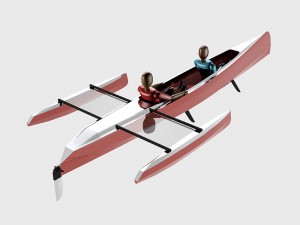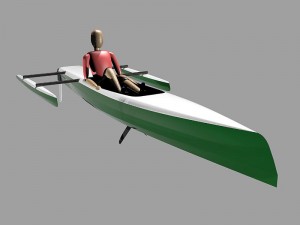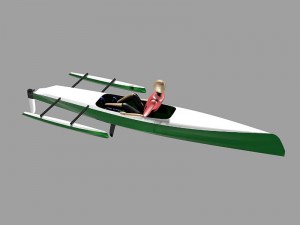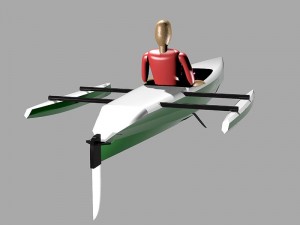STYLISH CRUISING FOR TWO

The A64 originally appeared as a design article on the pages of Duckworks Magazine back in 2006 (yeah, really!). When the boat was shown at the time, it was designed as a request from a friend of mine for he and his wife.
Since that time, I have revisited the design and taken a fresh look at the boat, its potential and the wide range of uses it might see while in use. There are more than a few revisions to the design in this iteration and I am very happy with the outcome.
Original Duckworks article here: http://www.duckworksmagazine.com/06/designs/a64/
While it would seem from outward appearances, that this boat would be a perfect fit with a modern rig like a Marconi, the truth is, I’ve been playing around with more traditional setups for the A64. Even though the A64 is capable of some pretty quick sailing, I was looking for a bit less of a hotrod, while very much wanting versatility in rig setup and handling. The boat has had its displacement potential enhanced just a bit so that it could easily carry the gear for a well-equipped camping and cruising scenario. I see the boat being used for long, extended weekends on the water, so the extra capacity is a welcome change.
A64 SPECIFICATIONS:
LOA – 21’
BOA (vaka hull) – 31”
BOA (trailer width) – 7’ 8”
BOA (complete boat) – 9’ 10”
LWL – 20’ 11”
BWL – 21.5″
Displacement – 1160 lbs.
Prismatic Coefficient – .56
Sail Area – 103 sq. ft. up to 166 sq. ft. (skill dependent)
Weight – 225 lbs.
Much of the inspiration for the A64 is due to the design of Joe Henry’s truly sweet, Flaquita tacking outrigger. I’d always liked the compact beauty and well thought-out utility of Flaquita and it has remained so, even after the new revisions. There are still a small collection of images of Flaquita on the Web if you are Google adept.
It’s no secret that designers have been pilfering each other’s design cues for as long as man has been building boats. Far from being offended by the process, I find that it’s the very essence of the pilfering that allows for new ideas to be incorporated. These incorporated changes, in turn, have the potential to improve the usefulness, the performance and the strength of the boats so that everyone benefits.
Vaka Hull
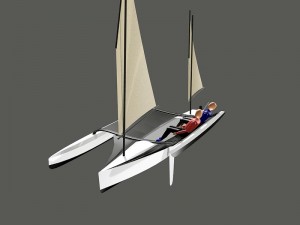 The revised vaka hull for the A64 is quite bit narrower than the initial design. It also draws more water with increased rocker. The initial boat was done to a very specific design brief that specified very thin water capability and a fairly short paddle length to the water. The new boat is basically a narrow hulled, multi-chined canoe form that is designed to optimize the displacement requirements while providing the least amount of wetted surface. The prismatic coefficient of a normal canoe hull has been changed to .56 to allow the boat to accelerate to speed comfortably and hold its speed with little effort. Paddling, while still comfortably possible, will probably be replaced by a small, 2 HP outboard engine… something like a Honda 2hp four stroke would be ideal. Close quarters maneuvering will likely be done with a paddle as paddles are truly effective when the movement space is tight.
The revised vaka hull for the A64 is quite bit narrower than the initial design. It also draws more water with increased rocker. The initial boat was done to a very specific design brief that specified very thin water capability and a fairly short paddle length to the water. The new boat is basically a narrow hulled, multi-chined canoe form that is designed to optimize the displacement requirements while providing the least amount of wetted surface. The prismatic coefficient of a normal canoe hull has been changed to .56 to allow the boat to accelerate to speed comfortably and hold its speed with little effort. Paddling, while still comfortably possible, will probably be replaced by a small, 2 HP outboard engine… something like a Honda 2hp four stroke would be ideal. Close quarters maneuvering will likely be done with a paddle as paddles are truly effective when the movement space is tight.
I drew the boat to have a typical, multihull trampoline surface on the ama side of the vaka hull and a non-typical trampoline surface on the off side that was inspired by Flaquita. To form a mental picture of the tramp surface, picture one of those sling chairs you might have had when you were a young college dude. Simply, it’s a loose trampoline cloth slung from an outboard rail back to the hull gunnel with enough slack to provide a seat for the crew when they need to hike out. The rack is angled up to provide the backrest component of the seat as well as give water clearance when the boat is heeled to the offside. The tramp surfaces can be rolled-back away from the canoe hull gunnel to allow for traditional paddling. Take a look at the renderings to get the complete picture.
The vaka hull is decked to enclose the bow area back to the forward aka beam as well as the aft section behind the open crew compartment. A somewhat traditional cockpit rim is specified for the central opening so that the owners can install a large spray skirt covering. This rim will keep a lot of the wave wash out of the boat under sail and paddle, as well as increase structural integrity. The fore and aft decked sections provide for watertight storage as well as flotation, should the boat be swamped or capsized. Additional flotation is provided by the single large ama, as well as the new, safety ama. This boat is not going to sink, should some major operator error get it upside down. You may lose any unattached belongings, but the boat will not sink (well, short of driving it on a reef at speed, holing all the flotation chambers)
Ama Design
The redesigned ama reflects my current thinking for a stitch and glue built form of this type. I have increased the volume for more of a heeling resistance margin. The ama has also been reshaped to more efficiently shed water from the deck, should it become immersed completely while being driven hard. Where the previous ama had a large flat deck surface, the new one has angular shapes that bevel into a much narrower top deck. This will allow the ama to drive back to the surface and give a huge new margin of safety to the boat when sailed hard.
The form is still very full, as well as deep in the forward sections, putting the flotation where it is needed the most. The bottom profile of the ama tapers up and away from the water as it moves aft to maintain the least amount of wetted surface for the ama as it is pressed. The new ama is a high efficiency design with just under 100% displacement buoyancy of 1029 pounds when submerged to its deck. When coupled with the length of the aka beam, the ama volume represents a considerable amount of righting moment.
Most single outrigger designs will be parked with the canoe hull adjacent to another boat or dock. The generous ama buoyancy of the A64 allows it to be maneuvered so that the ama is right up alongside a dock and the crew can easily walk across the trampoline to go ashore. Two, full grown adults can stand on top of the ama and not come close to submerging the form.
As an alternate to this type of docking strategy, the off-side, safety ama, is hinged, allowing it to be swung up and over the vaka hull. This allows the boat to be drawn right up next to the dock for direct entry to the vaka hull.
Curved Aka Beams
There are two methods for building the aka beams. The simplest is to laminate 3mm (1/8″) hardwood strips on a form, glued together with epoxy. The builder then glasses the beam, fills the weave and varnishes to high gloss to reveal the beauty of the wood beneath.
If you wanted to go all-out, you could make an easily constructed, epoxy/glass, box beam structure. The leading edges of the box beam would be further shaped in foam to give the beam an aero/hydrodynamic form as presented to the wind and waves. The entire form is then glassed for a finished beam and then painted as desired.
The akas attach to the canoe hull with simple cinch buckle straps much like those used to tie-down boats to roof racks. I have found this system to be extremely dependable, economical and the straps are very simple to replace if one breaks or is misplaced.
If the A64 is trailered, the main ama remains mounted to the hull and the offside ama, which is hinged, swimgs up and over the vaka. Transport width for the boat in this configuration is just under 8’ and well within legal limits. This makes for an incredibly fast setup and take-down at the launch ramp. The only work involved is in stepping the rigs, mounting the rudder and attaching the offside hiking tramp.
The Rig
The base design specifies a balanced Lug rigged yawl. The main mast will be rigged with a 70 sq. ft. sail and the mizzen will fill-out at 33 sq. ft. The balanced Lug provides simplicity in rigging and reefing and is surprisingly powerful, stows inside the hull with ease and could also be built quickly and economically in poly tarp, if the owner is so inclined and finances dictate.
Alternate Rig Solutions
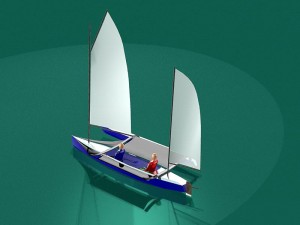 The boat has also been drawn as a 131 sq. ft. Gunter yawl, if the desire for more performance is there. In fact, there are many rig configurations that could be run on this boat and I’d like to see builders experiment a bit to find the magic for their own adventures.
The boat has also been drawn as a 131 sq. ft. Gunter yawl, if the desire for more performance is there. In fact, there are many rig configurations that could be run on this boat and I’d like to see builders experiment a bit to find the magic for their own adventures.
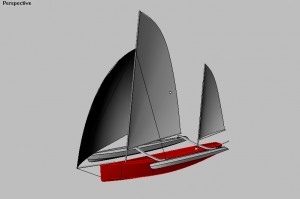
For those who seek a bit more in their sailing adventures, I have also drawn the A64 with a 156 sq. ft. Marconi yawl rig. Along with this rig, there is an option for a 124 sq. ft. Gennaker flown from the forward mast. With the spinnaker flying, one could expect that this boat will be quite quick in favorable, offwind conditions, capable of covering a lot of distance in a short time.
The Foils
The vaka hull will be equipped with a leeboard that is mounted to the port side of the hull. It will rotate for shallow water and be of a planform and foil section that will provide the best balance of lift and minimized drag for the sailing speeds of the boat. Typically, I like my leeboards on boats of this type to be NACA 0009 sections.
Likewise, the rudder’s characteristics will match the needs of the boat’s performance and it will be able to flip-up when it contacts underwater obstacles, or is beached while down. I do this with a simple bungee on the leading edge of the rudder, well above the waterline. The bungee holds the rudder down with sufficient force to overcome water pressure while sailing, but it easily stretches, allowing the rudder to swing up and aft if the blade contacts anything more substantial. The rudder foil will be a NACA 0012 section, to maximize control and minimize stall for low speed maneuvering.
The A64 will be very easy to build, it will be very light weight for its size and, therefore, quite easily driven in even the lightest of winds. The boat will carry a sizeable load for a very long weekend on the water. I wouldn’t be surprised at all if a couple of adventure cruisers could pack enough stuff on board for an entire week away from a source of supply.
It can be sailed comfortably in the thinnest of water and if the wind dies, this boat can be effortlessly propelled with traditional paddles for reasonable distances… or the crew can simply fire-up the Honda and go wherever their gas tank allows them. Perhaps this isn’t a real big issue for a lot of cruising boaters, but the A64 will be capable of surprising speed under sail. That will be especially true if equipped with the larger sail rig.
Adaptable, Modular Design
As a last little bit, to put an element of curiosity into the design package, there is a very nice folding trimaran with a comfortable solo cabin that is derived from this same vaka hull design that I will introduce in the very near future called the A21.
Any and all comments, or questions, about this design or the upcoming A21 are encouraged.
CHRIS OSTLIND
LUNADA DESIGN
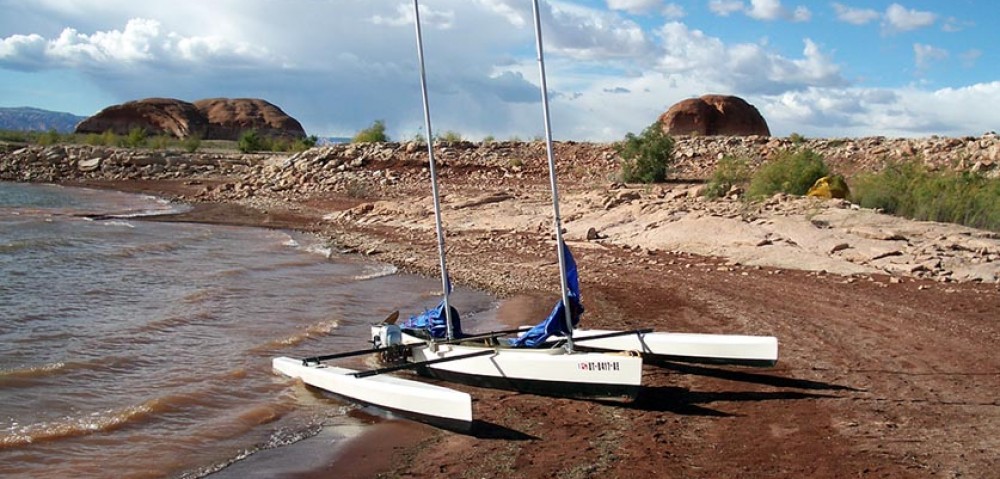
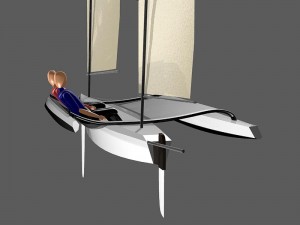
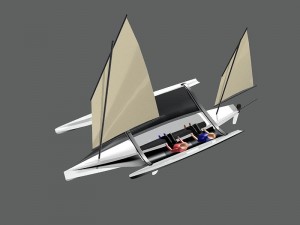
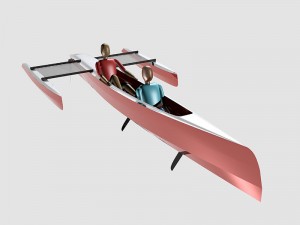
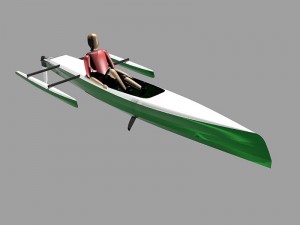 being a double Mirage setup and the 17relying on a single Mirage.
being a double Mirage setup and the 17relying on a single Mirage.